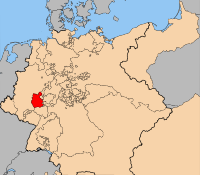This article needs additional citations for verification. (September 2014) |
Duchy of Nassau Herzogtum Nassau (German) | |||||||||||||
|---|---|---|---|---|---|---|---|---|---|---|---|---|---|
| 1806–1866 | |||||||||||||
| Status | State of the Confederation of the Rhine (1806–1813) State of the German Confederation (1815–1866) | ||||||||||||
| Capital | Weilburg (1806–1816) Wiesbaden (1816–1866) | ||||||||||||
| Common languages | Moselle Franconian | ||||||||||||
| Government | Constitutional monarchy | ||||||||||||
| Duke | |||||||||||||
• 1806–1816 | Frederick Augustus | ||||||||||||
• 1816–1839 | William | ||||||||||||
• 1839–1866 | Adolph | ||||||||||||
| Historical era | Modern era | ||||||||||||
• Established | 30 August 1806 | ||||||||||||
| 23 August 1866 | |||||||||||||
| Currency | Kronenthaler | ||||||||||||
| |||||||||||||
The Duchy of Nassau (German: Herzogtum Nassau) was an independent state between 1806 and 1866, located in what is now the German states of Rhineland-Palatinate and Hesse. It was a member of the Confederation of the Rhine and later of the German Confederation. Its ruling dynasty, now extinct, was the House of Nassau.[1][2] The duchy was named for its historical core city, Nassau, although Wiesbaden rather than Nassau was its capital. In 1865, the Duchy of Nassau had 465,636 inhabitants. After being occupied and annexed into the Kingdom of Prussia in 1866 following the Austro-Prussian War, it was incorporated into the Province of Hesse-Nassau. The area today is a geographical and historical region, Nassau, and Nassau is also the name of the Nassau Nature Park within the borders of the former duchy.
Today, the Grand Duke of Luxembourg still uses "Duke of Nassau" as his secondary title, and "Prince" or "Princess of Nassau" is used as a title by other members of the grand ducal family. Nassau is also part of the name of the Dutch royal family, which styles itself Orange-Nassau.
- ^ Grand Duchess Charlotte abdicated in 1964, but she died in 1985
- ^ Clotilde Countess of Nassau-Merenberg is the last patrilineal descendant of the House of Nassau though she descends from a family considered to be non-dynastic



